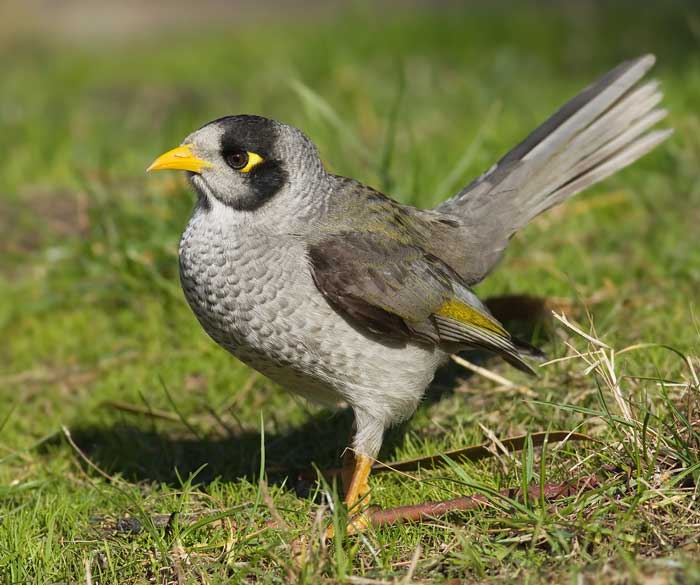Manorina melanocephala (*) Cladus: Eukaryota Name Manorina melanocephala (Latham, 1802) Vernacular names Noisy Miner Reference Supplementum indicis ornithologici p.xxviii The Noisy Miner (Manorina melanocephala) is a bird common to the eastern and southern states of Australia. It ranges from northern Queensland along the eastern coast to South Australia and Tasmania. Its typical diet consists of nectar, fruit and insects, and occasionally it feeds on small reptiles or amphibians. Somewhat opportunistic, the Miner will also feed on grains and can be seen foraging in grasslands although its normal habitat is scrub and woodlands. It has adjusted to urban areas far better than most other birds, given their preference for shorter grasses and thinner underbrush. Taxonomy First described by ornithologist John Lathamin his 1802 work Supplementum Indicis Ornithologici, sive Systematis Ornithologiae, the Noisy Miner is one of four species in the genus Manorina in the large family of honeyeaters known as Meliphagidae. Its species name is derived from the Ancient Greek words melas "black", and kephale "head". Molecular analysis has shown honeyeaters to be related to the Pardalotidae (pardalotes), Acanthizidae (Australian warblers, scrubwrens, thornbills, etc.), and the Maluridae (Australian fairy-wrens) in a large Meliphagoidea superfamily.[1] Description
Vocalisations Their 'Noisy' name is obvious when encountered, for their alarmed warning shrills are echoed across the colony as all members are alerted to your presence. Far softer are their social, talkative clicks, peeps and squeaks. Distribution and habitat
The Noisy Miner is very adaptive and inhabits degraded woodlands readily, and is considered that it will become more common with climate change.[1] Behaviour
Feeding Its typical diet consists of nectar, fruit and insects, and occasionally it feeds on small reptiles or amphibians. Somewhat opportunistic, the Miner will also feed on grains and can be seen foraging in grasslands although its normal habitat is scrub and woodlands. Breeding Unfortunately, many Noisy Miners like nesting over 'short' grass so much that they frequently build over grassless areas - such as roads and parks. Those that are not run over are often brought in to veterinary clinics as birds, where they may be euthanised depending on state law. In South Australia and New South Wales they may be kept with a Rescue Permit & a Class II license respectively. Nonetheless fauna rescue volunteers remain reluctant to take them on because of their territorial and aggressive nature, causing integration problems with their other rescued birds. The preference for shorter grasses in nesting areas seems related to a strong tendency for the young to 'fall' out of the nest a week before they can fly. The young will find a bush or low branch to begin their journey back up into the tree, while some member of the family typically stands guard to warn off any intruders. Shorter grass allows the adult better view of approaching predators. Eggs are laid in clutches of 2-4 eggs, rarely 5, approximately 3 cm long by 2 cm wide with reddish brown spots concentrated around the wide end. Time between eggs can be around 22 to 26 hours, and incubation starts with the second egg laid. Nests are cup shaped, 4 to 5 inches in diameter. Territoriality Recent experiments have shown that noisy miners aggressively expel many other species of birds from their territories. Noisy miners were removed from seven patches of Box-Ironbark or grey box forest, and the recolonisation by other species of birds was monitored over several years. The study showed that at six of the seven noisy miner-free areas created, the diversity and abundance of other insectivorous birds increased markedly. This increase did not occur at the matching control sites where noisy miners were not removed. The removal of noisy miners from a grey box remnants near Violet Town, Victoria, led to a major and rapid change in the abundance and composition of the bird community. In particular, there was a significant influx of small insectivorous birds, consistent with the hypothesis that noisy miners normally exclude these species from such sites. The overall influx of birds may have been due to a combination of the removal of the aggressive Noisy Miner and the flowering of the eucalypts at the time of removal.From Grey et al. 1997. They are very active birds, easily distressed by being caged, often violent towards other birds kept with them, and thus difficult to domesticate compared to traditional companion birds. Lorikeet & Honeyeater feed sustains them, supplemented well with Finch or Insectivore rearing food (mixed with a little egg and bread crumbs), blossoms with nectar and fresh fruit daily where possible. They will generally try out any offerings. As with most birds, salt, avocado, caffeine and chocolate are toxic even in small quantities. Dairy products are not recommended either. References 1. ^ Barker, F. Keith; Cibois, Alice; Schikler, Peter; Feinstein, Julie; Cracraft, Joel (2004). "Phylogeny and diversification of the largest avian radiation" (PDF). Proc. Natl. Acad. Sci. USA 101 (30): 11040–45. doi:10.1073/pnas.0401892101. PMC 503738. PMID 15263073. http://www.tc.umn.edu/~barke042/pdfs/Barker.et.al04.pdf. Retrieved August 3, 2010. * BirdLife International (2004). Manorina melanocephala. 2006. IUCN Red List of Threatened Species. IUCN 2006. www.iucnredlist.org. Retrieved on 12 May 2006. Database entry includes justification for why this species is of least concern Source: Wikipedia, Wikispecies: All text is available under the terms of the GNU Free Documentation License |
|

